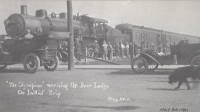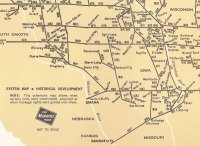|
One thing this in-fighting
showed the Milwaukee’s management was that its railroad needed to do some
more growing, if it were to stay competitive with railroads that reached
the Pacific Coast, either in California or Washington and Oregon. The
Milwaukee couldn’t prosper by turning over the more profitable long-haul
business to other lines.
More and more, it seemed
that the Milwaukee should be extended to the Pacific, although the company
was divided for a time on whether it should go straight west or northwest.
Director William
Rockefeller, as late as 1905, still thought the line should be built to
California. For a while he was seriously thinking that it should be built
in cooperation
with the North Western, which — like the Milwaukee — ended in Omaha. while he was seriously thinking that it should be built
in cooperation
with the North Western, which — like the Milwaukee — ended in Omaha.
One thing that did seem
clear was that the company had ample resources for extending itself, since
it was soundly financed and highly respected by financial men, who
considered it one of the best-run railroads in the country.
By 1901, the Milwaukee had
6,596 miles of track, its farthest northwest point being Evarts, N. D., on
the Missouri River.
In that year, A. J. Earling,
the Milwaukee’s president, sent an engineer to estimate how much it would
cost to duplicate the Northern Pacific’s line to the Pacific Northwest.
The engineer thought $45 million would do it.
 After much deliberation, the
company’s decision was made:
go northwest. After much deliberation, the
company’s decision was made:
go northwest.
On November 28, 1905, the
board of directors voted to build the line to Seattle and Tacoma.
|
